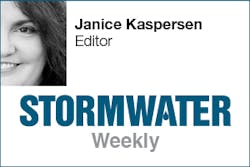
This is perhaps a bit removed from the subject of stormwater, but it’s very much about reuse, so I’m including it here as a sort of holiday message for those of you who take encouraging news wherever you can get it. A project in Washington DC is turning human waste into energy on a large scale, producing enough energy to power an entire wastewater treatment plant, which would otherwise be purchasing coal-based electricity from the grid.
This is perhaps a bit removed from the subject of stormwater, but it’s very much about reuse, so I’m including it here as a sort of holiday message for those of you who take encouraging news wherever you can get it. A project in Washington DC is turning human waste into energy on a large scale, producing enough energy to power an entire wastewater treatment plant, which would otherwise be purchasing coal-based electricity from the grid. [text_ad] Although the process has been used elsewhere—it’s known as Norwegian thermal hydrolysis—this is the first large-scale project in the US to employ it. The Blue Plains Advanced Wastewater Treatment Plant, which accepts waste from Washington DC and surrounding areas, treats more than 370 million gallons of wastewater a day and produces more than 1,200 wet tons of biosolids. The treated water is released to the Potomac River and the Chesapeake Bay. It’s what the plant does with the biosolids that’s making news. This article describes the process:Most of the solid waste is turned into compost or fertilizer, but a new initiative started earlier this year is diverting some the solids collected from the bottom of the water treatment pools into energy generation…. [The thermal hydrolysis process] maximizes the amount of biogas produced from the digestion of sludge. The hydrolysis process relies on bacteria to break down the organic waste in 80-foot-tall vats capable of decomposing up to 3.8 million gallons of biosolids. The byproduct of this digestion is methane, which then is used to generate 13 megawatts of electricity using turbines. Of the energy that is produced, 3 megawatts are used for the hydrolysis while the remaining 10 megawatts are piped back into the plant to meet its power needs.
Since 2012, the city of Oslo, Norway, has had a system in place using this process to convert food waste to fuel that runs, among other things, the city’s public buses. Several cities in China and the UK are also using the process, as well as a handful of others in Europe, Chile, and Australia.Although the process has been used elsewhere—it’s known as Norwegian thermal hydrolysis—this is the first large-scale project in the US to employ it.
The Blue Plains Advanced Wastewater Treatment Plant, which accepts waste from Washington DC and surrounding areas, treats more than 370 million gallons of wastewater a day and produces more than 1,200 wet tons of biosolids. The treated water is released to the Potomac River and the Chesapeake Bay. It’s what the plant does with the biosolids that’s making news. This article describes the process:
Most of the solid waste is turned into compost or fertilizer, but a new initiative started earlier this year is diverting some the solids collected from the bottom of the water treatment pools into energy generation…. [The thermal hydrolysis process] maximizes the amount of biogas produced from the digestion of sludge. The hydrolysis process relies on bacteria to break down the organic waste in 80-foot-tall vats capable of decomposing up to 3.8 million gallons of biosolids. The byproduct of this digestion is methane, which then is used to generate 13 megawatts of electricity using turbines. Of the energy that is produced, 3 megawatts are used for the hydrolysis while the remaining 10 megawatts are piped back into the plant to meet its power needs.
Since 2012, the city of Oslo, Norway, has had a system in place using this process to convert food waste to fuel that runs, among other things, the city’s public buses. Several cities in China and the UK are also using the process, as well as a handful of others in Europe, Chile, and Australia.About the Author
Janice Kaspersen
Janice Kaspersen is the former editor of Erosion Control and Stormwater magazines.


